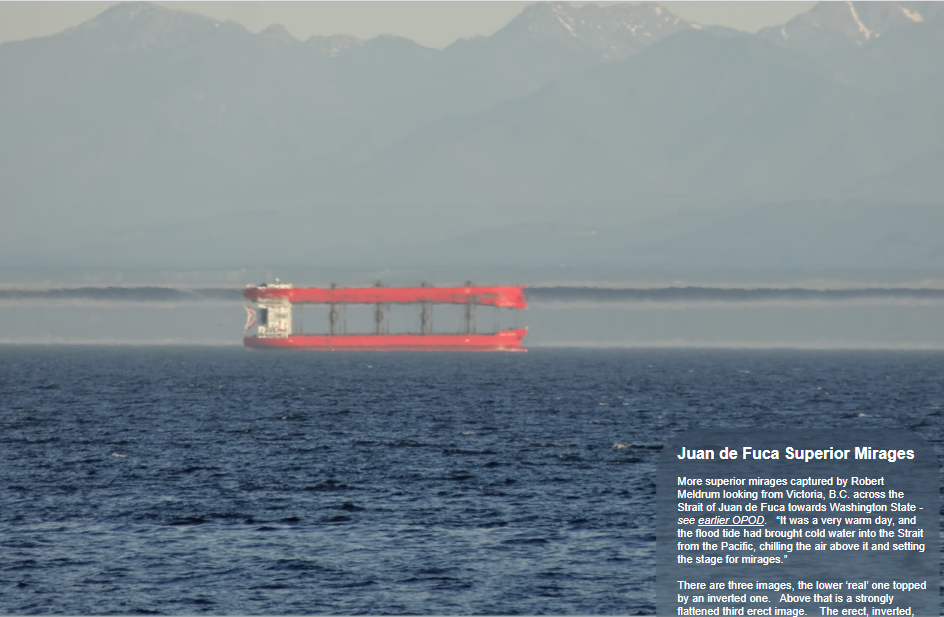Miraged Ships, Juan de Fuca - OPOD
Miraged Ships, Juan de Fuca - OPOD: A Stunning Atmospheric Phenomenon
When it comes to atmospheric optics, few phenomena captivate the imagination like mirages. These optical illusions can transform our perception of reality, creating surreal and breathtaking scenes. One such mesmerizing display is the miraged ships seen across the Strait of Juan de Fuca, as beautifully captured by photographer Robert Meldrum.
On a warm day, with the flood tide bringing cold water from the Pacific into the Strait, a perfect recipe for mirages is created. The chill in the air above the cold water sets the stage for these ethereal illusions to take place. Meldrum's photographs reveal three distinct images, each with its own unique characteristics.
The lower image represents the actual appearance of the ships, while the inverted image sits atop it. Sandwiched between these two is a third image that appears strongly flattened. This sequence of erect, inverted, erect images perfectly adheres to the rules of mirage formation, showcasing the intricate interplay between light and atmospheric conditions.
One striking feature of these mirages is the "hole in the hull" effect observed on the upper ship(s). This phenomenon occurs due to the miraging of the sea between the inverted and erect images. The result is a visual illusion that appears as though there is a gap or opening in the ship's hull, adding to the surreal nature of the scene.
Mirages are not static; they are dynamic and ever-changing. Even slight adjustments in our viewing perspective can significantly alter their appearance. Meldrum noticed that a mere change in camera position, either by crouching or standing, resulted in a noticeable transformation of the miraged ship's image. The effect was further amplified when he held the camera overhead. Similarly, shifting a few feet right or left on a mildly sloping sidewalk had a similar impact. It is fascinating to witness how mirages can evolve within a matter of minutes, captivating observers with their fluidity.
The miraged ships of Juan de Fuca serve as a reminder of the incredible complexity of atmospheric optics. These phenomena are not only visually stunning but also offer valuable insights into the behavior of light in our atmosphere. By studying mirages, scientists can gain a deeper understanding of atmospheric conditions, such as temperature gradients and the bending of light rays.
Mirages are not limited to maritime settings; they can occur in various environments around the world. Desert mirages, for example, often create the illusion of water or distant oases shimmering on the horizon. These optical illusions have fascinated explorers and travelers throughout history, often leading to misconceptions and legends about hidden treasures or mythical lands.
In conclusion, the miraged ships of Juan de Fuca are a captivating example of the wonders of atmospheric optics. The interplay between temperature, air density, and light refraction creates a visual spectacle that challenges our perception of reality. By capturing these ephemeral moments through photography, we can appreciate the beauty and complexity of our natural world. Mirages remind us to embrace curiosity and seek a deeper understanding of the phenomena that surround us.

Juan de Fuca Superior Mirages
More superior mirages captured by Robert Meldrum looking from Victoria, B.C. across the Strait of Juan de Fuca towards Washington State - see earlier OPOD. “It was a very warm day, and the flood tide had brought cold water into the Strait from the Pacific, chilling the air above it and setting the stage for mirages.”
There are three images, the lower ‘real’ one topped by an inverted one. Above that is a strongly flattened third erect image. The erect, inverted, erect rule is nicely obeyed!
The 'hole in the hull' on the upper ship(s) is miraged sea between the inverted and erect images.
©Robert Meldrum, shown with permission

This image of another ship was taken less than a minute later.
"Only last week, I noticed a miraged ship’s appearance change significantly when I went from crouching (to steady my camera on a low wooden fence), to standing, a vertical change of camera position of only two feet! Holding the camera overhead furthered the change!! I had previously noticed that moving a few feet right or left on a mildly sloping sidewalk had a similar effect. Mirages can also change from one minute to the next as you watch them."
Note: this article has been automatically converted from the old site and may not appear as intended. You can find the original article here.
Reference Atmospheric Optics
If you use any of the definitions, information, or data presented on Atmospheric Optics, please copy the link or reference below to properly credit us as the reference source. Thank you!
-
<a href="https://atoptics.co.uk/blog/miraged-ships-juan-de-fuca-opod/">Miraged Ships, Juan de Fuca - OPOD</a>
-
"Miraged Ships, Juan de Fuca - OPOD". Atmospheric Optics. Accessed on November 15, 2024. https://atoptics.co.uk/blog/miraged-ships-juan-de-fuca-opod/.
-
"Miraged Ships, Juan de Fuca - OPOD". Atmospheric Optics, https://atoptics.co.uk/blog/miraged-ships-juan-de-fuca-opod/. Accessed 15 November, 2024
-
Miraged Ships, Juan de Fuca - OPOD. Atmospheric Optics. Retrieved from https://atoptics.co.uk/blog/miraged-ships-juan-de-fuca-opod/.